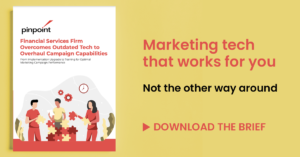A colleague sent me this piece from Adobe recently, about why trust and data privacy are the keys to effective personalization. I couldn’t agree more. We built Pinpoint around several core ideas, and one of the biggest ones was that effective MarTech stack usage comes from effective personalization – but you absolutely cannot get to effective personalization unless your customers and partners trust you, and trust that you’re doing right by their information.
The Adobe piece begins by mentioning Home Depot, noting its spot in home repair retail. More than half the U.S. population makes an average of two trips per year to a brick and mortar Home Depot, and they also do about $151 billion in e-commerce annually, which makes them the fifth-largest e-comm site in the world. They have a massive footprint and a wide network of customer relationships, and it’s not just because they have better lighting sconces than competitors. It’s because customers trust them with their privacy.
As Adobe notes:
In striving to create a more seamless online to offline shopping experience, The Home Depot allowed customers some ownership of what data they were willing to share and demonstrated how this would benefit them. Customers can upload their wish lists into The Home Depot mobile app, and once in store, the app then directs them to the correct aisle and bin number to find the right kitchen faucet, sledgehammer, or tube of adhesive. This approach allowed the team to iterate based on ingested customer data and follow up with more impressive features.
Establishing a unified data system while prioritizing privacy, security, and governance is at the heart of building a winning customer data management strategy.
Another thing Home Depot has done in recent years is unify their view of metrics from online and offline channels. This gives them a full picture of customer behavior, and it makes personalization easier. Home Depot did a “kitchen sink” play where they combined website activity, in-store activity, return activity, call center volume, cancellations, and more. That allowed them to improve customer experience both in-store and online – which speaks to their massive sales numbers.
A really simple way to see this connected data/personalization aspect is that with Home Depot, most are shopping by project. So if someone buys vinyl flooring on Tuesday, you can target them with a floor cleaner or stainer as the weekend begins. We all know that home projects can become all-consuming focuses. That’s an email or a push you won’t ignore. And it can happen, at the right time, because they’re doing personalization right. And they’re able to do personalization right because they don’t screw up customer data. People trust them.
Now we come to the elephant in the room, though: Home Depot is a massive brand, with billions of dollars of capital. They can afford to have best-of-breed personalization and privacy. Can you?
The short, realistic answer is: Not necessarily at their level. But can you? Absolutely.
At Pinpoint, we actually believe there’s a continuum of executing personalization successfully. On one end, you have expensive consultancies telling you that you can run like Home Depot if you pay up. You also have scrappy (read: cheap) options on the other side. Both options are extreme, and not particularly helpful.
The truth is that you can likely achieve high levels of personalization with your existing tech stack. There are clever ways to exploit tech, even if it isn’t the latest-and-greatest thing out there. By pulling together existing customer data, implementing thoughtful integrations, improving your testing processes, you have a better foundation of what your organization truly needs to invest in. It takes some strategic chops and the technical know-how to emulate the functionality that giant brands are rolling out, but just because you don’t have a Home Depot budget, doesn’t mean you can’t roll up your sleeves with the right partner and figure out how to get more from your marketing technology.
Now let’s land the plane on privacy vs. personalization. Sometimes we talk about these concepts in MarTech as separate entities, but they’re not. It’s a giant, looping ecosystem. Without privacy, there’s no trust. Without trust, there’s no data coming in. Without data coming in, there’s no personalization. Without personalization, you’re just blasting messages out. It all works together. That’s how personalization and marketing automation is done right.




